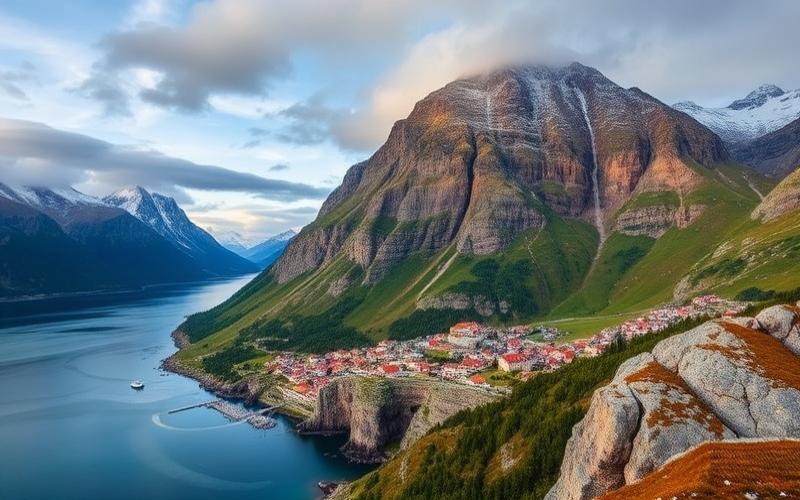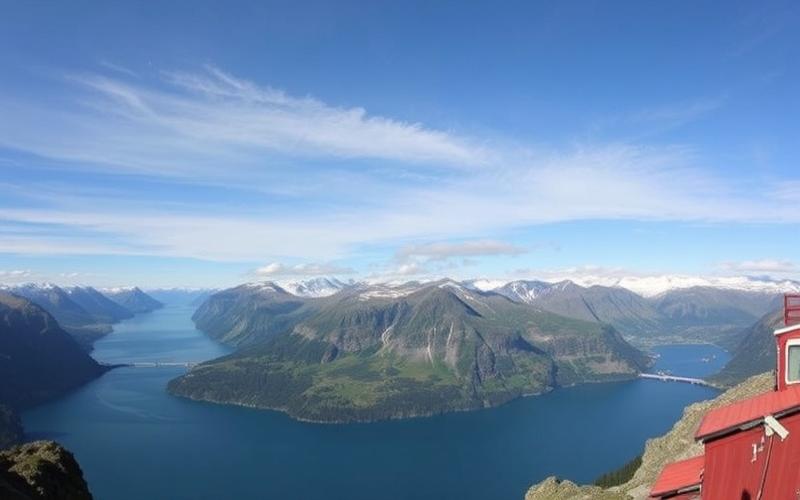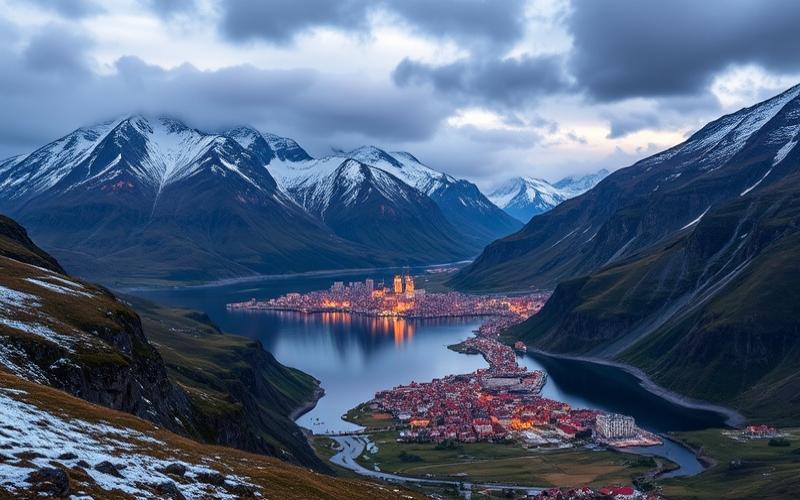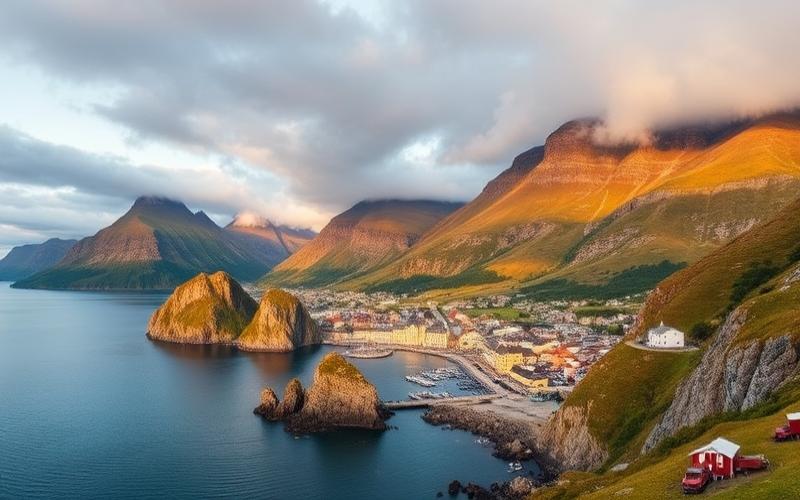
 Published on and written by Cyril Jarnias
Published on and written by Cyril Jarnias
Relocating to Norway, synonymous with breathtaking landscapes and exceptional quality of life, can prove to be a real challenge for expatriates when it comes to managing their finances.
Navigating the Norwegian cost of living is crucial for ensuring successful integration, as this Nordic country is renowned for its high prices across various aspects of daily life.
Whether it’s housing, food, or essential services, understanding the variations in these costs can make all the difference.
Expatriates must therefore prepare not only for the charms of the Great North but also for carefully planned financial management to live comfortably in this attractive destination.
Understanding the Cost of Living in Norway: Comparisons and Concrete Examples
Norway ranks among the most expensive countries in the world, with an overall cost of living 32% higher than in France in 2025. This price difference is explained by several structural and economic factors that shape the Norwegian market.
Determining Factors of the Cost of Living
High wages form the foundation of this expensive economy. The average monthly salary reaches €3195, which partially offsets the high prices for residents. However, this mechanism does not apply to tourists or new arrivals.
The tax and protectionist policy of the Norwegian state plays a major role. The standard VAT rate stands at 25%, the second highest in Europe after Hungary. This aggressive taxation is accompanied by a protectionist strategy that heavily taxes imported products, especially when local equivalents exist. This practice explains why many Norwegians cross the Swedish border to buy candy, meat, alcohol, and tobacco at significantly reduced prices.
High labor costs are reflected in all services and products. Compared to European Union countries, Norway has a cost of living index of 78.88, placing it 6th globally.
Housing: The Dominant Budget Item
Housing represents the largest monthly expense for residents. Renting an apartment in downtown Oslo costs around €1713 per month. For those with more limited budgets, a small room in a shared apartment starts around 5000 NOK (approximately €450).
Tourist accommodation prices vary by type of establishment. A night in a guesthouse or bed and breakfast costs an average of €120, which is 16% cheaper than in France. A family hotel room amounts to €206 per night, also 14% cheaper than the French average. The average price per room per night reaches 1725 NOK (approximately €155).
The housing sector absorbs a considerable portion of the budget, with an overall housing cost (rent, subscriptions) on average 19% more expensive than in France.
Food: Significantly Higher Prices
Food costs 40% more in Norway than in France. This increase affects all basic products:
| Product | Price Norway | Price France | Difference |
|---|---|---|---|
| Milk (1L) | €2 | €1.16 | +69% |
| Bread (500g) | €6 | €3.55 | +69% |
| Rice (1kg) | €2.9 | €2.34 | +24% |
| Gasoline (1L) | €1.9 | Variable | Comparable |
These substantial gaps reflect both the high taxes and local production costs.
Transportation and Mobility
Gasoline costs €1.9 per liter in Norway, a relatively competitive price compared to other European countries. However, public transport subscriptions and other mobility fees follow the general upward trend.
Leisure and Dining
Leisure activities show an increase of 49% compared to France. Specific rates illustrate this rise:
- A movie ticket costs €14.5 in Norway versus €12 in France (+22%)
- An hour of tennis court rental amounts to €30 versus €17 in France (+75%)
- A restaurant lunch reaches €22
- An inexpensive meal costs 230 NOK (approximately €21)
Consumer Goods
Consumer goods purchases are 7% more expensive than in France. A pack of Marlboro cigarettes costs €13.8 versus €12 in France, reflecting the high taxation on tobacco.
Geographical Variations
The cost of living varies significantly by city. For a trip, the differences manifest as follows:
| City | Additional Cost Compared to France |
|---|---|
| Bergen | +45% (France) / +10% (Norway) |
| Stavanger | +43% (France) / +5% (Norway) |
| Trondheim | +40% (France) / +4% (Norway) |
| Oslo | +38% (France) / +5% (Norway) |
| Narvik | +24% (France) / -11% (Norway) |
Oslo and Bergen, the largest cities, display the highest prices. Narvik, located in the north, offers significantly cheaper rates. Rural regions generally offer lower prices than metropolitan areas, although precise data is lacking.
Real Purchasing Power Perspective
A crucial point to understand: although Norway is expensive, the local purchasing power is 8.7% higher than in France. This reality transforms the perception of the cost of living. For residents earning Norwegian salaries, the high prices remain accessible. However, this equation changes radically for tourists and new arrivals without local income.
Norway ranks 3rd among the richest countries in the world per capita, with excellent indicators of living standards and life expectancy. This collective wealth supports the economic system but creates a financially demanding environment for those in transition.
Financial Adaptation for Expatriates
The most relevant advice offered by established residents in Norway is to immediately stop comparing prices with France. Instead, new arrivals must compare prices to their local income and assess what remains at the end of the month. This perspective fundamentally changes the budget equation.
For students, the warning is explicit: one must arrive with substantial savings. Private daycare costs €245 per month (65% cheaper than in France), while private international primary schools amount to €6320 annually (39% cheaper than in France). These figures reveal that some educational services remain relatively accessible.
Norway therefore requires a mental adaptation: accepting that prices seem high in absolute value, but recognizing that local salaries make them viable for those working in the country. This dynamic explains why many expatriates, after an initial adjustment period, discover better purchasing power than they would have anticipated.
Good to Know:
In Norway, the high cost of housing can be offset by a salary generally higher than in many European Union countries; for example, a monthly rent in Oslo is around €1,500, while weekly groceries amount to approximately €100.
What Budget to Plan for an Expatriate in Norway? Examples and Advice
| Category | Example Average Cost (€/month) | Details and Practical Tips |
|---|---|---|
| Housing | 1,500–1,713 | 3-room apartment in the city. To reduce costs, opt for shared housing (from €500 in Oslo), or settle outside urban centers (rents from €800). |
| Food | 400–600 | Groceries 40% more expensive than in France. Shop in supermarkets, cook at home, avoid restaurants (inexpensive meal: €20). |
| Transportation | 68–100 | Monthly public transport pass (bus, subway). Use public transportation to limit expenses. Single bus ticket: €3.8–4. |
| Gasoline | €1.85–1.90/L | For cars, plan a substantial fuel budget. |
| Health Insurance | 20–40 | Doctor’s consultation: €20, medications reimbursed at 62%. Plan for private insurance if not covered by Norwegian social security. |
| Leisure | 100–150 | Movie ticket: €14.5. Gym membership: €55–110/month. Enjoy free activities: hiking, open museums, local events. |
List of Tips to Optimize Your Budget:
- Prioritize shared housing or co-living, especially in large cities.
- Settle in the suburbs or rural areas for lower rents.
- Buy in bulk and take advantage of supermarket promotions.
- Avoid eating out; cooking yourself saves money.
- Use efficient public transportation instead of cars or taxis.
- Participate in home exchanges, couchsurfing, or carpooling.
- Enjoy free leisure activities (nature, parks, public events).
- Join barter groups or local associations to reduce certain expenses.
Impact of Norwegian Krone (NOK) Fluctuations:
Variations in the NOK against the euro or dollar can impact expatriates’ budgets.
It is advisable to monitor the exchange rate and anticipate money transfers or major purchases during favorable periods.
Expatriates paid in foreign currencies must plan considering this volatility.
Cost of Living Differences by Location:
| Location | Rent (€/month) | Food | Transportation | Leisure |
|---|---|---|---|---|
| Oslo (center) | 1,500–1,713 | +40% | +74% | High |
| Medium City | 800 | +30% | +60% | Medium |
| Rural Region | 500–800 | +10% | +30% | Low |
Large cities (Oslo, Bergen) are significantly more expensive than rural regions.
Transportation and leisure cost more in urban areas.
Rural regions offer more accessible prices and a less expensive lifestyle.
Useful Resources for Estimating Monthly Expenses:
- Use online cost of living simulators for Norway.
- Consult specialized platforms (Numbeo, Combien-coute.net) for updated prices.
- Inquire with expatriates via forums or Facebook groups.
Tip for New Arrivals:
Plan a sufficient installation budget (first month’s rent, security deposit, insurance fees).
Anticipate unexpected expenses: furniture purchases, subscriptions, administrative fees.
Keep a margin for price and currency fluctuations.
Key Takeaway:
Norway offers a high standard of living but requires rigorous budget planning, especially for expatriates in large cities. Enjoying natural resources and efficient public services helps lighten the overall bill.
Good to Know:
Prepare an average monthly budget of 15,000 to 25,000 NOK, with 50% dedicated to housing, opting for public transportation and exploring local markets for more economical food options; keep in mind that fluctuations in the Norwegian krone can affect costs, especially in large cities like Oslo.
Tips for Living Comfortably in Norway Without Breaking the Bank
For traveling on a small budget, several practical tips allow you to maximize savings while fully enjoying your stay.
Choosing Affordable Accommodations
- Prioritize accommodations located outside major urban centers, where prices are often lower.
- Use comparators like Cozycozy, Kayak, Skyscanner, or Agoda to find hotels, hostels, or apartments at the best rate.
- Opt for guesthouses or bed and breakfasts, often economical and friendly.
- Book outside tourist seasons or take advantage of last-minute offers.
| Accommodation Comparators | Types of Offers Available |
|---|---|
| Cozycozy | Hotels, Airbnb, hostels |
| Kayak | Hotels, hostels |
| Skyscanner | Hotels, apartments |
| Agoda | Hotels, bed and breakfasts |
Economical Transportation
- Use a bicycle for local travel: practical, eco-friendly, and inexpensive.
- Prioritize public transportation: bus, subway, tram, often offered with reduced fares for students, youth, or families.
- Take advantage of special cards and passes for frequent or tourist travel.
Groceries and Food
- Buy local products at markets to benefit from attractive prices and fresh products.
- Prepare your own meals in a shared kitchen or equipped accommodation.
Tracking Promotions and Deals
- Use specialized websites and applications to spot current offers: Voyages Pirates, Weekendesk, Skyscanner.
- Subscribe to price alerts to be informed of drops or flash sales.
| Deals Apps & Websites | Main Function |
|---|---|
| Voyages Pirates | Accommodation deals |
| Weekendesk | Stays under €100 |
| Skyscanner | Price comparator |
Free or Low-Cost Activities
- Enjoy hiking, bike rides, or nature outings.
- Inquire about free museum days (e.g., first Sunday of the month).
- Participate in local events or festivals open to the public.
- Discover heritage and monuments accessible freely.
Budget Planning
- Establish a precise budget before departure: accommodation, transportation, food, activities.
- Track daily expenses using management apps or a simple spreadsheet.
Adopting the Local Lifestyle
- Observe the habits of locals to avoid unnecessary expenses.
- Adapt to local schedules, transportation modes, and shops to benefit from advantageous rates.
Tips to Remember:
- Always compare prices before booking.
- Prioritize local markets for your food purchases.
- Check free access days to museums and monuments.
- Use a bicycle or public transportation for your travels.
- Adapt your pace of life to that of the locals to save money.
These tips allow for smart travel, limiting expenses while fully discovering the chosen destination.
Good to Know:
Opt for cheaper accommodations on the outskirts, use bicycles or transportation discounts, buy at the local market, and explore free activities like hiking or visiting museums on free days; apps like Too Good To Go also help find promotions.
Disclaimer: The information provided on this website is for informational purposes only and does not constitute financial, legal, or professional advice. We encourage you to consult qualified experts before making any investment, real estate, or expatriation decisions. Although we strive to maintain up-to-date and accurate information, we do not guarantee the completeness, accuracy, or timeliness of the proposed content. As investment and expatriation involve risks, we disclaim any liability for potential losses or damages arising from the use of this site. Your use of this site confirms your acceptance of these terms and your understanding of the associated risks.




















